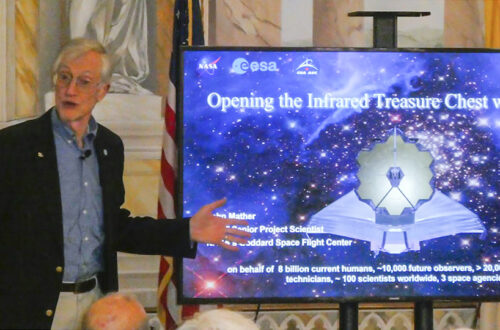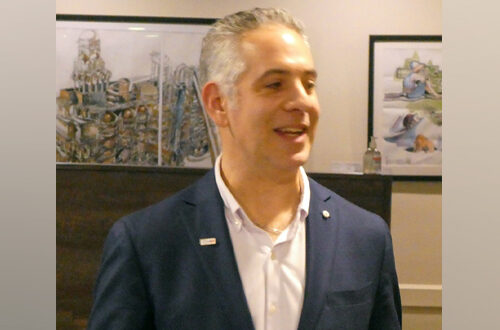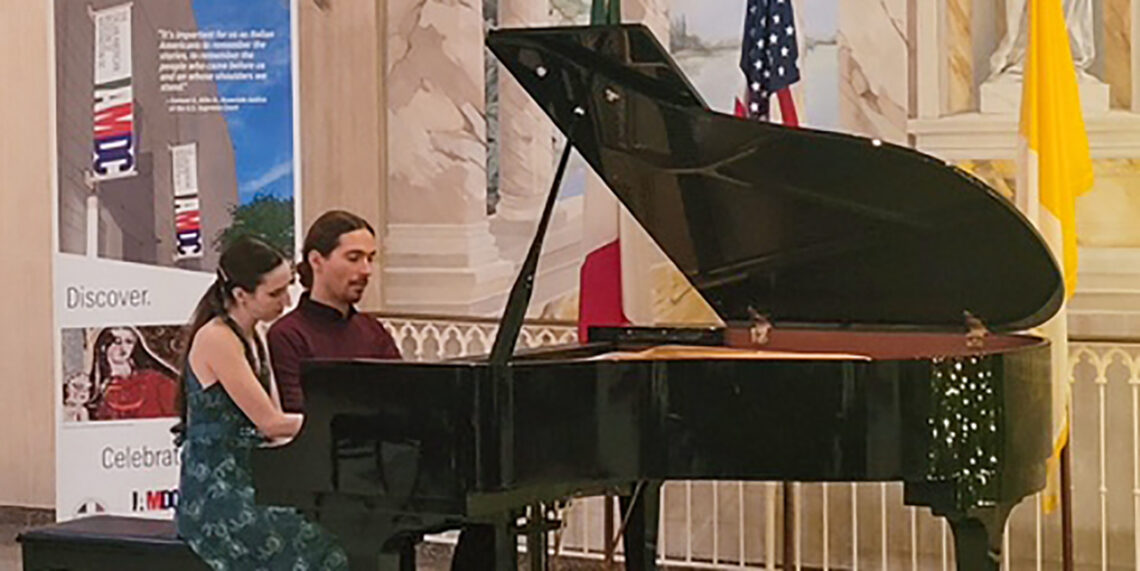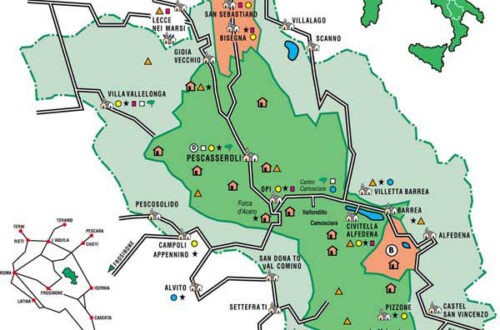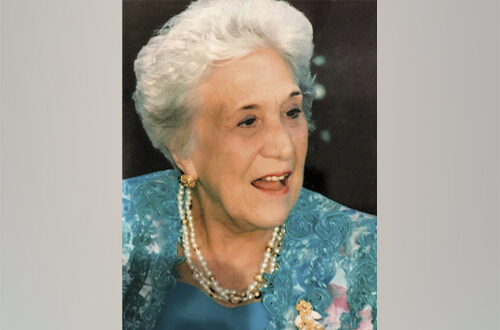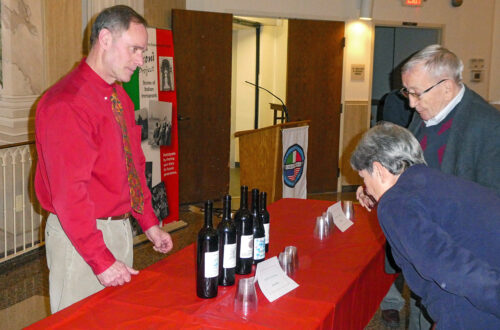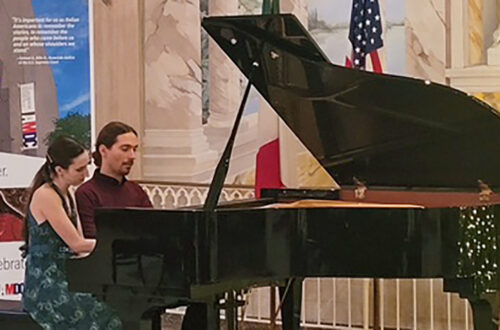-
AMHS Membership
By Lynn Sorbara, 2nd Vice President-Membership
New Members Welcome to our New Members: Karen De Luca Birthdays Compleanni a Marzo
Eileen Parise Del Monaco, March 1; Greg Bernabei, March 2; Maria Fresco, March 3; Stephen D’Alessio, March 5; Salvatore DiPilla, March 8; Charles Philip D’Adamo, March 9; Maria Antoinette Kellaher and Sam Yothers, March 12; Mary Petrino, March 14; Joanne Balzano, March 16; David Scalzitti, March 19; Pam Lupo, March 21; Diana Hoopes, March 23; Thomas Ronan and Benjamin O’Hara, March 24; Mary Katherine Theis, March 25; Natalie Lui Ducan, March 26; Lucio D’Andrea, March 28; Macarena Clark, March 29; and Anna Maria DiPilla, March 31.Compleanni a Aprile
Albert Grasso, April 1; Joseph Theis, April 4; Susan Ann Bonsiero, April 5; Diana Bernabei, April 6; Donald Kellaher, April 10; Angela Petruzzelli, April 13; Teresa Talierco Scafetta, April 14; Dominic Balzano, Stephen Ulissi and Elena Francini-McGrann, April 21; Julia Conti, April 22; Berardino Palazzo, April 24; Belinda Sabatini, April 25; Christopher Renneker, April 26; Joann Novello, April 28; Tommaso Profenno and Rita Costello, April 30.Anniversaries Anniversari a Marzo
Robert & Marlene Lucian, March 3; Albert & Karen Grasso, March 4; Maria Antoinette & Donald Kellaher, March 22; and Raymond & Barbara Bernero, March 26.Anniversari a Aprile
Anthony & Norma Phillips, April 14; Michael & Elizabeth Iademarco, April 20; and Roberto & Bess DiTullio, April 25.Membership Information Category # of Persons
Associate (Couple): 2 x 2 = 4
Associate (Individual): 39
General (Couple): 51 x 2 = 102
General (Individual): 79
Honorary: 9
Scholarship: 2
Student: 5
Total Membership: 240
March/April 2023
-
Pianists from Rome Delight Audience at Casa Italiana
By Nancy DeSanti, 1st Vice President-Programs
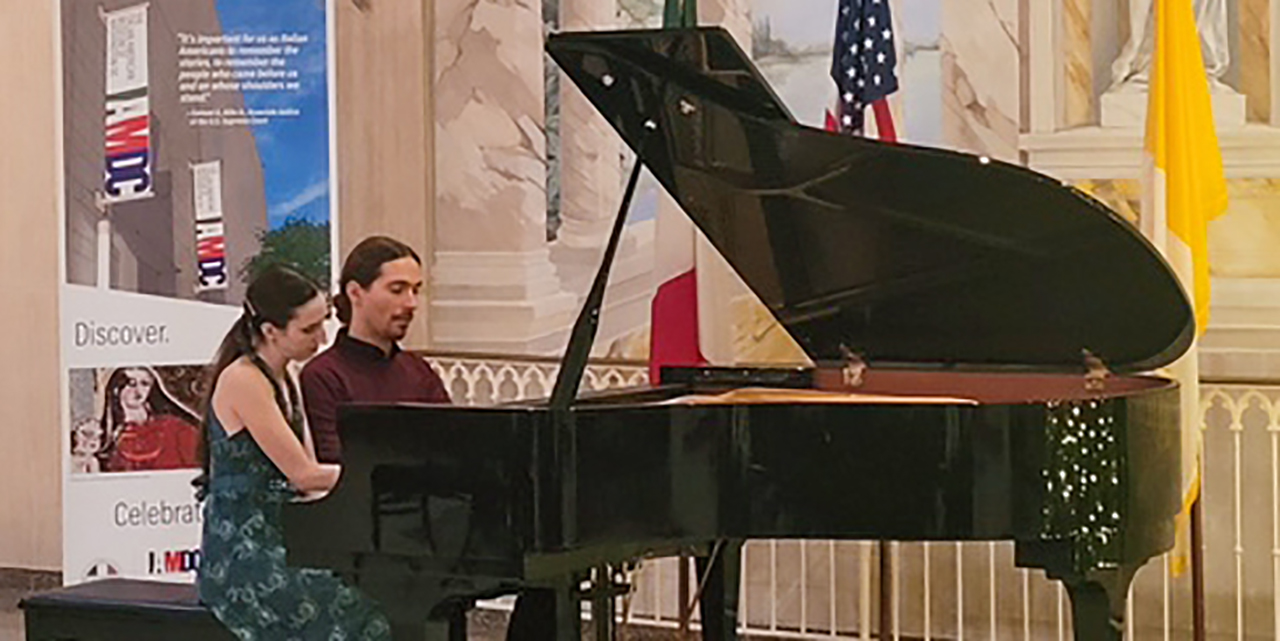
Talented musicians Vincent Catalano and Katrina Sudman performed for an appreciative audience at Casa Italiana.
Credit: Gabriela LaVerghettaAMHS members and their guests were recently treated to an outstanding performance by two very talented pianists visiting from Rome. The musicians, Vincent Catalano and Katrina Sudman, performed at Casa Italiana on December 11, 2022.
Their trip had been months in the planning, since AMHS President Ray LaVerghetta visited Italy last spring. That is when he met Vincent and his wife Katrina who now live in Rome. They finally arrived here a few days before the concert and were hosted by Peter Bell and then Robert D’Onofrio.
This was their only performance in the Washington, D.C., area, and they said they selected a special program for us, beginning with Scarlatti’s Sonata in D Major and ending with Rossini’s Overture to La Gazza Ladra (the Thieving Magpie), a very Italian piece and a real crowd-pleaser. Then, they delighted the audience with several four-hand piano duo selections. Their repertoire was inspired by Italian opera, song, and dance.
Vincent Catalano was born in L’ Aquila, in Abruzzo, where he graduated with the highest possible scores at the G. Braga Conservatory in Teramo. He then graduated with a Master’s Degree in Piano Interpretation-Composition, summa cum laude. He perfected his musical studies with internationally renowned pianists, Aldo Ciccolini and Carlo Maria Dominici, with whom he is currently studying and who himself studied with famed pianist Vladimir Horowitz.
Vincent has won a number of piano competitions including the “8th Concorso Nazionale di Cittá S. Angelo” held in Pescara, Abruzzo, where he performed at the event “Dal’Etna al Gran Sasso Tradizioni in Festa.” He also won 1st place at the “10th Concorso Internazionale Paolo Barrasso di Caramanico Terme”, also held in Pescara, and 2nd place at the “17th Concorso Nazionale Flegreo in Pozzuoli” held in Napoli.
In addition to various piano master classes, he participated in many concerts in Rome, Saracinesco, Pescara, Gaeta, Napoli, and Viterbo. He also performed in Teramo for the “150 years of Italy’s Unity” celebrations in 2011. He dedicates himself with passion to instrumental duos including a piano four-hands duo with Katrina, as well as with violin and flute.
Katrina Sudman is from the Chicago area, and currently lives in Rome. She earned her Master of Music in Piano Performance from the Chicago College of Performing Arts at Roosevelt University and her Bachelor of Music in Piano Performance, summa cum laude, from Azusa Pacific University in California. She now continues her studies privately with internationally acclaimed pianist Carlo Maria Dominici in Rome.
In 2018, Katrina took 2nd place in the International Piano Competition at the Festival of the Gulf in Salerno. She has performed in venues across the Chicago area, including the Grant Park Music Festival and the Chicago Botanic Gardens.
In addition to her solo performances, Katrina performs a four-hand piano duo with Vincent. Together they have performed throughout Chicago and in the Basilica of St. Anne in Detroit, which is the second-oldest continuously operating parish in the United States. She also collaborates with violinist Hsuan Chen of the Civic Orchestra of Chicago. She has been on faculty at Concordia University since 2017 as a piano instructor in the Preparatory and Community Piano Program.
The talented duo seemed to have really charmed the audience. They said that they enjoyed meeting attendees before and after the concert. They added that they felt very much at home in Casa Italiana.
A big thank you to all those who helped make the concert a success, especially Ray LaVerghetta, Peter Bell, Maria Marigliano, Lynn Sorbara, Richard Durkin, John Dunkle, and Julie Finigan Dal Forno. Unfortunately, Ray was unable to attend, so the pianists were introduced by Nancy DeSanti.
January/February 2023
-
A Message from the President

Dear members and friends:
Welcome to 2023. I extend warm New Year’s greetings to all our members and friends. Along with those greetings comes a sincere wish that all of us enjoy the best of health and happiness in the coming year.
At the beginning of each new year, I like to review some of the events that brought us together, in one form or another, during the previous year. Early last year, the resurgence of Omicron cases prompted us to postpone our in-person plans and switch to virtual events. Our first one was a discussion, led by filmmaker Jim Toscano, of the documentary “My Italian Secret: The Forgotten Heroes”, which told the story of the many Italians who helped Jews, partisans and refugees escape the ravages of the Holocaust during the Second World War. Our audience stretched across the coasts and feedback for the late January event was very positive. Then in February we presented “Italian Louisiana: History, Heritage, Tradition”, a virtual talk by historian and author Alan Gauthreaux. It informed us of the many ways in which Italian immigrants shaped the culture of New Orleans. We resumed our in-person format in March with author and tour guide Carla Gambescia, who spoke on the “A to Z of Italian Culture”. Casa Italiana was packed for this presentation and the full house was not disappointed. In April, we organized a short trip over to Tysons Corner Center in Virginia to view a Michelangelo Sistine Chapel exhibition, followed by a lunch at the Italian Oven restaurant in McLean. After this event, we featured a talk in May with TV personality and culinary expert Amy Riolo, who moderated a panel of well-known Italian chefs and food industry personalities. It was a great afternoon for everyone interested in Italian cuisine. May was also the month in which we awarded scholarships to two outstanding students — Marcella Finelli of the University of Maryland and William DiGiovanni of Georgetown University.
The month of July featured a virtual event in which the Chief Curator of the Smithsonian’s National Postal Museum talked to us about the Fascist style in Italian philately during the period 1922-1941. In August, we got together for our annual Ferragosto picnic at Ft. Ward Park in Alexandria, Virginia. Later that month, we presented another virtual program in which Edvige Giunta spoke to us about the Triangle Shirtwaist Fire of New York City in 1911. There was a happy hour in September at In Bocca al Lupo on Wisconsin Avenue NW in DC and another in-person event later that month which featured Eric Denker, the Senior Lecturer at the National Gallery of Art and an expert on the artistic treasures of Venice. We held our annual wine tasting event in November and then a classical music piano concert in December. Two additional events of note were the launching of our online shop and the introduction of a new music scholarship — the Angela Lastrico Raish scholarship which the AMHS will manage.
Looking ahead, please mark January 29th on your 2023 calendars. Dr. John Mather, a Senior Astrophysicist in the Observational Cosmology Laboratory at NASA’s Goddard Space Flight Center, will be our featured guest speaker. Dr. Mather was a co-recipient of the Nobel Prize in 2006 for his discoveries supporting the big-bang model. He is also the Senior Project Scientist on the James Webb Space Telescope. I am sure that we can all learn a lot from this renowned scientist.
I would like to thank our three Board members who finished their terms in December of last year: John Dunkle, Chris Renneker, and Sonny Scafetta. I simply cannot overemphasize the importance of their guidance and initiative in steering our organization over the duration of their time on the Board. At the same time, I welcome their replacements — Julie Finigan Dal Forno, John Iazzetti, and Teresa Margaret Talierco — and look forward to the contributions that they will make. I also must thank Maria D’Andrea-Yothers, who stepped down from the Board at the end of December 2022. Maria has been our organization’s greatest asset, both during her tenure as President and during mine as well. She has been amazing. Her connection with the AMHS began with its founding and she has shaped it over the years like no one else. I am in her debt, as indeed all members and friends should be.
By now you will have received in hard copy the 2022 Scholarship Fundraising appeal letter. Please look it over and, if possible, make a contribution to our campaign. We count on member donations exclusively to fund our two scholarships, which constitute perhaps our most important activity as an organization. Your donations make our two annual scholarships possible — it is as simple as that.
Thank you for reading and have a great year!
Best regards,
Ray LaVerghetta
January/February 2023
-
Nobel Prize Winner Dr. John Mather to Describe Work on Webb Space Telescope
By Nancy DeSanti, 1st Vice President-Programs

“Cosmic Cliffs” in the Carina Nebula
Credit: webbtelescope.orgAMHS is pleased to start our new year of programs for 2023 with a talk by Nobel Laureate Dr. John C. Mather on January 29, 2023, at Casa Italiana. Dr. Mather will tell us about his exciting work on the James Webb Space Telescope, the largest optical telescope in outer space.

Nobel Prize Winner Dr. John Mather The program is co-sponsored by the Casa Italiana Sociocultural Center and the Casa Italiana Language School. The talk was facilitated by AMHS member Joe Novello, who was formerly a colleague of Dr. Mather at the National Aeronautics and Space Administration (NASA). Before his talk, a delicious lunch will be catered by Fontina Grille.
Dr. Mather is a senior astrophysicist at the NASA Goddard Space Flight Center in Maryland and adjunct professor of physics at the University of Maryland College of Computer, Mathematical, and Natural Sciences. In 2007, Time magazine listed Dr. Mather among the “100 Most Influential People in the World.”
Dr. Mather is an American astrophysicist, cosmologist and winner of the Nobel Prize in Physics in 2006 for his work on the Cosmic Background Explorer Satellite (COBE) with George Smoot. That work helped cement the Big Bang theory of the Universe. Dr. Mather is also the senior project scientist for the James Webb Space Telescope, a space telescope launched on December 25, 2021.
AMHS members may recall that Dr. Mather gave us a talk in March 2014 and described what it was like to receive the phone call that changed his life and then to be awarded the Nobel Prize at a ceremony in Sweden attended by the Swedish King.
During that talk, Dr. Mather told us that Italy is one of his favorite places to visit, and he noted that there is a town in Italy that sends flowers to the Nobel Prize ceremony every year (the Ligurian town of San Remo, where Alfred Nobel spent the last five years of his life.) When he was eight years old, he said he received a biography of Galileo from his parents, and from that time on, Galileo became one of his heroes.
During his upcoming talk on January 29, Dr. Mather will tell us about his work on the James Webb Space Telescope, for which NASA led the design and development and partnered with two main agencies — the European Space Agency (of which Italy is a member) and the Canadian Space Agency.
Recently, the James Webb Space Telescope captured a unique perspective of the Universe, including never-before-seen galaxies described as glittering like diamonds in the cosmos. One research astronomer commented, “the stunning image quality of Webb is truly out of this world.” We look forward to hearing about Dr. Mather’s work on this exciting project.
January/February 2023
-
Former D.C. Bar President to Speak on Career, Growing Up Italian
By Joseph “Sonny” Scafetta, Jr.

Chad T. Sarchio
Credit: Courtesy of Chad T. SarchioAt a special AMHS luncheon on Sunday, February 12, 2023, we will hear from Chad T. Sarchio who served as the 50th president of the D.C. Bar from July 1, 2021 to June 30, 2022. He was the third Italian-American lawyer to serve in that post since the D.C. Bar was established in 1972, and only the second government lawyer to do so. Chad will talk about his career and growing up Italian.
The luncheon will be held in the Il Canale Restaurant, 1063 31st St., N.W., Washington, D.C., at 1:30 p.m. Our guest will speak after the lunch is served. A question-and-answer period will follow. For reservations, please email Nancy De Santi at ndesanti7@gmail.com and Sonny Scafetta at joseph.scafetta.jr@gmail.com. Please note that this is not one of the Society’s general meetings. No prepayment is required; attendees will order and be responsible for their own meals at the restaurant.
Chad grew up in New Jersey, about a half hour northeast of New York City. His father worked for the state of New Jersey in human resources and his mother was a high school English teacher. During elementary and high school, he was a member of the Boy Scouts and rose to the highest rank of Eagle Scout.
After graduating from high school, he received a scholarship from the National Italian-American Foundation (NIAF) and entered the Public Policy Program at Duke University in North Carolina. He also received a U.S. Army Reserve Officers Training Corps (ROTC) scholarship. After earning his undergraduate degree and receiving his commission as a second lieutenant, he went to law school at George Washington University.
After obtaining his law degree, he served on active duty in the Judge Advocate General (JAG) Corps for four years and stayed in the U.S. Army Reserves for 20 more years. His first assignment was at Fort Bragg, N.C., working in legal assistance and claims positions. Then, in the Fall of 1997, he began a six-month deployment to Bosnia and Herzegovina as a senior foreign claims commissioner. He completed his active service as military counsel to the Army’s Auditor General. During his service, he married another lawyer, the former Christina Guerola, with whom he has two children.
After leaving active duty, he served as a federal prosecutor in the U.S. Attorney’s Office in D.C. for more than six years, prosecuting a wide range of violent and white-collar crimes. In the Fall of 2005, he worked on a Senate Select Committee investigation into the response to Hurricane Katrina, which had hit the Gulf Coast. As a reservist, he later taught at the U.S. Army JAG Corps School. In the Spring of 2016, he became a military judge. He retired from the U.S. Army and its trial bench as a lieutenant colonel in 2019.
He has worked as an associate chief counsel for the U.S. Drug Enforcement Administration (DEA) since 2006 and has lectured in trial and appellate advocacy at George Washington University for more than 20 years. During his spare time, he repairs and maintains classic cars.
January/February 2023


